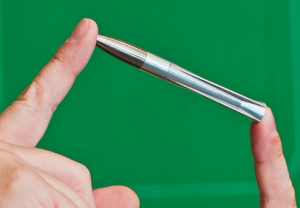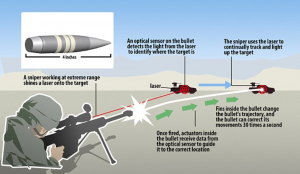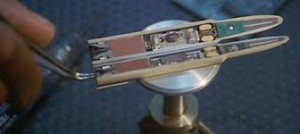In the pursuit of power, mankind has often followed the path of war after diplomacy yielded no results. In this regard, countries have always looked for ways to tip the scales of power in their favor: from the invention of the first trebuchet to the use of the atomic bomb, the technological advancements made in warfare have been mind-blowing. Even though some of these advancements have often led to the bettering of societal technologies, there have always been tragic costs associated with wars – the loss of innocent life. In recent wars, there has been a climb in these types of deaths. To battle the loss of life associated with stray bullets or inaccurate shootings, technological advances have been researched to mitigate this growing trend.

DARPA, the Defense Advanced Research Projects Agency, has recently unveiled a new type of bullet that would decrease the inaccuracy of bullets fired. The process of controlling this aspect would mitigate both the loss of innocent life as well as target the not-so-innocent groups during times of war. Dubbed the EXACTO bullet (extreme accuracy tasked ordinance bullet), it would be capable of adjusting its flightpath to the specifications described by the shooter. The controlling variable in this scenario would be the flight path of the bullet. If the flight path of a bullet could be pre-determined, it would both increase the chances of success in a mission as well as decrease the chances of civilian casualties. A good operating range would then be the bullet finding its appropriate mark; a bad operating range would be hitting anything besides its appropriate mark. Since the saving of innocent life is always paramount in any given situation, the control of this specific variable would be very critical to the operation.
To control this application, several factors would have to be taken into account. To test the potential of controlling the accuracy of a bullet, DARPA has looked into incorporating controlling mechanisms into 50 caliber bullets. These large caliber bullets are typically associated with long range sniper rifles that rely on large amounts of precision and accuracy due to the long distance that usually exists between the shooter and target (up to 1500m). Although bullets are fired from these rifles at roughly 800m/s, several factors come into play at such extreme lengths that can alter its path. Some possible factors include wind speed, humidity, temperature, elevation above sea-level, air resistance, muzzle velocity, and gravity. Since it is impossible to control disturbance factors, such as wind speed or temperature, the technology within and on the bullet would work to counteract these factors, or would be constantly fed through some controlled process to account for these variables. A control system that could compensate for these factors would minimize the human error that arises from shooting at long distances.
Moving targets pose the largest challenge for shooters. In most scenarios, snipers will wait until the target is stationary before taking their shot. If that controlled variable cannot be achieved, a new decision comes into play: the anticipation of where the target will be at a given time in the future. Regular bullets do not change their trajectory once released from the barrel, so if the target moves, the bullet could miss the target and hit someone else who wandered unwittingly into its path. At such great distances, the chance of this happening is higher than for close-up shots, so snipers must take enough time to set up before taking a long-distance shot. Once the shot is taken, the shooter’s position becomes compromised, and the opportunity to hit the target has passed. “Locking” onto the target and having the bullet change trajectory in response to the target’s motion, or even incorrect aim, could significantly increase the number of bullets that reach their targets. DARPA’s team has been able to correct for this by controlling the bullet to change trajectory in response to the moving target.

The bullet uses a feedforward response system, meaning it will detect the change in location of its target while both are in motion, and it will alter its direction in order to re-focus on its target. DARPA has not unveiled its full secrets surrounding the technology of the bullet; however, the basic mechanism for the path change is known. It does so by following a laser-designated mark, altering its flight path by moving small fins up to 30 times a second, to adjust for changes in position. With this new technology, targets should be hit more often, allowing soldiers to fight more effectively than ever. Similar technology has proven efficient in smart bombs; however, the challenge here was developing electronics that would be small and capable enough to fit inside the base of the bullet. Additionally, not only would the bullets be more accurate, but they would also allow for shots to be taken more quickly. The bullet will be able to account for inaccuracies in aim, which will allow the sniper to be slightly less accurate and much faster at taking a shot. Their ability to move in and out of position quickly will reduce the risk they pose to themselves and their unit by compromising their position.

This YouTube video demonstrates and explains the target-locking technology:
https://www.youtube.com/watch?v=PjdEweHYxEk
Some sample moving-targets are shown in this YouTube video:
https://www.youtube.com/watch?v=YoOaJclkSZg
Large leaps in bullet technology have already been made. Over the course of centuries, bullets have progressed from round, spherical shapes, to the elongated egg forms with a pointed end, which are used today. This step significantly cut down on the air resistance the bullet encounters, leading to the increase in the total travel distance of the bullet through the air (from 100 yards when using Civil War muskets to roughly 7,000 yards for the sniper rifles used today). With small changes having such significant effects, all factors should be considered when attempting to make an improvement towards a certain goal. To improve accuracy, the factors that need to be controlled the most are wind speed and the location of the target. Large gusts of wind can derail a bullet from its flight path, and the flight path of an ordinary bullet does not change based on movement of the target. Because of the tiny fins located on the shell of the bullet, obstacles, such as these, could be overcome with a slight adjustment relayed from the laser-marked target to a guidance system located in the bullet. Since controlling these outside factors is impossible, the next step forward would be to counteract these effects by inserting a feedforward loop. A feedforward loop works by monitoring disturbances in the path of the bullet before it reaches its intended target. The control system will monitor the wind speed and location of the person, and if either of these change, the controller will alter the path of the bullet before it hits the person. If the system works properly, the target will be hit every time.

Moving forward, many challenges arise that make the design of this system difficult, and limitations require alternative ideas. Since the bullet would still be travelling at such high velocities, any type of system correction would have to be done in less than three seconds (taking into account the distance to the target is roughly 2400 meters away). Because of this limited window of correction, a fail-safe should most likely be installed, which would cause the bullet to self-destruct or stop mid-flight.
With improved technology, the country will grow stronger. War will be completed more efficiently, and more soldiers will return home quickly and safely. Fewer civilians will be lost in the process. These bullets could provide the technological advantage needed to come to a quick resolution regarding political conflicts while minimizing the interaction of those not directly involved.